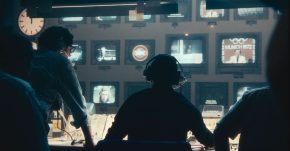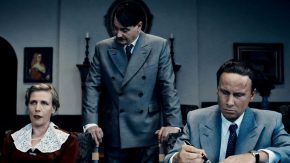Müpa Budapest celebrated its 15. birthday this month. Although they had to cancel planned concerts due to the covid-19 situation, you can still celebrate the round anniversary with them. On their website, you can now enjoy 80 HD concert video recordings and 40 literature night audio recordings without registration. We collected seven from the most various genres because we believe you should see and hear them all!
1. Haydn: The Creation
We really need some Haydn at the moment. Something proportionate, moderate, sober and healthy – just like what he left in music history. His clear and perfect technique always stays for joy, shiny feelings and ideas. His time was the zenith of aristocracy and got inspiration for The Creation during his visit in England. This is one of the most popular oratorios of all times. This concert, conducted by Ádám Fischer in 2017, features such great singers as Emőke Baráth, Uwe Stickert, and Miklós Sebestyén.
The Creation fits well to Emőke Baráth’s repertoire of baroque and First Viennese School music. Miklós Sebestyén is has been a star of international stages with oratorios. Uwe Stickert, mostly known as a Mozart singer, shows how great he is in this genre as well. Ádám Fischer’s conducting style is one more lovely tidbit: he passionately leads the orchestra and the choir without a music sheet. Close-ups help us feel really close to the orchestra and notice all kinds of little details. This enchanted music speaks about creative energies and the faith in our world and humanity, which can bring some happiness to our upside-down current days. If you need encouragement or just some angelic music to recharge – listen to this recording.
You can find it here: https://www.mupa.hu/media/video/haydn-a-teremtes
Genre: oratorio
Artists: Ádám Fischer, Emőke Baráth, Uwe Stickert, Miklós Sebestyén, the Purcell Choir, and the Orchestra and Choir of the Age of Enlightenment (UK)
Duration: 1 h 42’
When to listen to it: to start a new day, or before going to sleep.
2. Joyce DiDonato and the Complesso Barocco
If we have not been to the live concert of Joyce DiDonato mezzo-soprano and the Complesso Barocco, a group founded in Italy in 1992 for mainly Italian operas and oratorios that plays on historical instruments, we can now feel sorry about it. No issue, the gracious beauty of Joyce DiDonato and her perfect voice, supported by the orchestra, will still enchant us through the screen. This recording is a real time travelling experience in the age of baroque with opera arias and pieces to tourist-guide us.

We should be prepared to meet important personalities: queen regnants and queen consorts, princesses, all authentically portrayed by Joyce DiDonato, switching between different characters easily. She has, apart from her royal voice, a royal attire as well, and she is marvellous as the betrayed Octavia from The Coronation of Poppea or as Cleopatra from Handel’s Julius Caesar. She can also be seen as the Queen of Palestine or as Iphigenia, awakening ancient times and showing the eternal struggles of women throughout history. Her passionate and strong voice enchants everyone and she receives a huge applause at the end. Complesso Barocco shows us how much novelty baroque brought into music: we can here pieces with different intensities and rhythms, and we it never get bored!
You can find it here: https://www.mupa.hu/media/video/joyce-didonato-es-a-complesso-barocco
Genre: opera arias and baroque music
Artists: Joyce DiDonato and the Complesso Barocco
Duration: 1 h 54’
When to listen to it: in the evening when we finished everything for the day and have some time to soak into great music.
3. Take 6
They took six and are still together since then! US-American gospel sextett was founded in 1980 in Alabama. They have fifteen albums, many more singles and Grammy awards behind them. The tenor and baritone voices sing a cappella and bring gospel together with jazz, groove, and funky, thereby having their original sound. The recording also captures how hard it is for the audience to remain seated, and for us in our living rooms, nothing prevents us to really start to dance, clap and sing with the performers. Take 6 even play well-known songs like Stand By Me or some Michael Jackson hits.

They are experts in having a party mood with great voices, humour, easily understandable lyrics, virtuose melodies, all in one recording, and of course we should not forget the main basis of the genre: spirituality. After this recording, you will understand why these guys became such frequent guests on the stage of Müpa.
You can find it here: https://www.mupa.hu/media/video/take-61
Genre: a capella gospel jazz, groove, funk
Members: Alvin Chea, Mark és Joel Kibble, Claude McKnight, David Thomas, Khristian Dentley
Duration: 1 h 20’
When to listen to it: when we want some happiness, movements and carefree fun.
4. Kornél Horváth: Metamorphoses
Konga, bongo, udu, hang drum, gatodrum, darbuka, shaker, timbales – these are only a few from the long list of percussion instruments that Kornél Horváth brilliantly plays. We should remember while watching the recording that these instruments are the most ancient and were not only used for music but for communication. Kornél Horváth remains intact by the new wave of electronic instruments, so we can see and hear them all in their original forms.
He also invited guests for the concert and plays duos with Zoltán Lantos (violin), Zoltán Orosz (accordion) and Gábor Dörnyei (drums). Enjoyable musical dialogues unfold as the rhythms reply and even argue with each other, and as the music gets stronger or weaker, slower or faster, until we realise we are dancing with it. Kornél Horváth’s performance gets its energy from very deep and ancient roots, and we cannot escape the great effects of joyful music. Start the recording with a smile!
You can find it here: https://www.mupa.hu/media/video/horvath-kornel-atvaltozasok
Genre: percussion highlights, including duos with violin, drum and accordion
Artists: Kornél Horváth, Zoltán Lantos, Zoltán Orosz, Gábor Dörnyei
Duration: 1 h 49’
When to listen to it: anytime as background music, and also if we start to miss a long walk or excursion. It is also great for home sports or dance.
5. Swan Lake by the Szeged Contemporary Dance Company, children edition
Müpa knows very much how hard it is to stay at home with children all the time these days, so they included something for them as well. The dance company does not have it in its repertoire anymore, so this might be the only place to find it now. It was recorded in 2014 and lasts circa 50 minutes – a great fun for young people aged 10-14. A great advantage of this version is the live interpretation of Tchaikovsky’s fabulous music by the MÁV Symphonic Orchestra.
SzCDC also comes up with unusual elements, like boys dancing in the swan roles. The ducks and frogs of the lake is a lovely comic relief in this otherwise melancholic and deep story. We can feel the storytelling power of ballet, no matter if it is classic or contemporary. Tamás Juronics’s choreography masters in the metamorphosis of Odette to Odilia, and the whole play is true to the story with a lot of creative and progressive elements. It does not sacrifice the music for the plot and shows a very good cooperation between the dancers and the orchestra. A show centred around children, also involving them at some parts, which can give you at least an hour spare time while at home with your little ones!
You can find it here: https://www.mupa.hu/media/video/szegedi-kortars-balett-a-hattyuk-tava
Artists: Szeged Contemporary Dance Company, MÁV Symphonic Orchestra, director-choreographer: Tamás Juronics
Duration: 50’
When to listen to it: when we want to entertain the kids, or if it is us who want to repeat and newly interpret a classic of ballet.
6. We had a dream. German-Hungarian literature chanson night I-II.
One of the debut chansons say: “Berlin is a pile of dung… We have to leave from here, over now… Pest is ruined, Buda is snobbish”. Climate, according to the song, is horrible both in Berlin and in Budapest, but how great it was during Communism! The lyrics, written by Zsolt Máthé, speak about the common enemy and even the gentry world was fine. The obscure start comes from an orchestra formed by actors and translators from the group HANEM. György Dalos is moderating the discussion of Terézia Mora, Ingo Schulze, Péter Esterházy, Zsófia Bán and György Dragomán. It is so great to hear Esterházy again, amusing his colleagues with his intellectually funny anecdotes, the way they all do here.

Writer György Dalos, winner of the Milán Füst Prize, lives in Berlin since 1995. He asks his colleagues about their first trip to West Berlin. It is a humorous way to bring back the absurdity of the Kádár’ian soft dictatorship. All of these Hungarian writers have published in German and Ingo Schulze in Hungarian. But how does it work? How can a Hungarian or German author be popular in the other cultural or literature context? What role does translation play? How did they deal with mistranslated phrases? Terézia Mora speaks a lot about the latter, as she has been translating Hungarian writers to German. All writers read from their latest books and the spoken programme is sometimes interrupted by the chansons of the HANEM orchestra, most of them familiar, like Mein Herr from the musical Cabaret. This is an all arts experience, you can have fun and learn something new while listening to it. Directed by Réka Pelsőczy.
You can find it here: https://www.mupa.hu/media/digitalis-irodalom/volt-egy-almunk-nemet-magyar-irodalmi-sanzonest-i
And here: https://www.mupa.hu/media/digitalis-irodalom/volt-egy-almunk-nemet-magyar-irodalmi-sanzonest-ii
Members: Terézia Mora, Ingo Schulze, Péter Esterházy, Zsófia Bán, György Dragomán, György Dalos, the HANEM Orchestra: Lídia Nádori, Márta Murányi, Zsófi Rick, Kriszta Bíró, Ági Sváb, János Jammal Fekete, Róbert Rick. Creators: Lídia Nádori (dramaturge), Zsolt Máthé (song translator), Zsolt Czakó and Balázs Balogh (production designer), Tibor Keresztury (series editor).
Duration: the two recordings are ca. 60 minutes together.
When to listen to it: in the evening or late afternoon if we are ready to dive deep in a cultural question and learn something new about the world of literature.
7. Bojtorján – a concert of their life and times
Emblematic figure of Hungarian country music, the Bojtorján Ensemble is active since 1977 and came back to stage after a long break with the idea of showcasing their latest hits. The group plays its well-known songs from their six albums together with a classical orchestra. They sing about love, breakups, vagabond life, sometimes with sorrow but mostly with joy and an eternal love for life, songs that remain actual forever. Their simple melodies are easy to sing along – and we can do it at home, thinking back to the days of our and the Bojtorján boys’ life with nostalgia. It is great to see how their music can still bring this country band together, and they perform here just like they did at the biggest international country festivals, despite all the professional and personal difficulties they had to go through.
You can find it here: https://www.mupa.hu/media/video/csavargodal-bojtorjan-eletmukoncert
Members: the band Bojtorján (Zoltán Pomázi, Andor Vörös, Győző Kemény, László Buchwarth, Zoltán Barna) and their guests
Duration: 1 h 47’
When to listen to it: in every part of the day as main or even background music, but at a time when we surely won’t disturb anyone with singing along.
Article: Anna Rácz
Translation: Zsófia Hacsek



























Comments